Exploring the Majesty of Ostriches: Africa’s Graceful Giants
Ostriches in Africa. In the vast savannas and grasslands of Africa, where the sun kisses the earth with its warmth and the wind whispers tales of ancient times, roams one of the continent’s most iconic creatures: the ostrich; Standing tall and proud, with feathers fluttering in the breeze, these magnificent birds captivate the imagination of all who encounter them; These magnificent creatures Ostriches, scientifically known as Struthio camelus, are these largest birds on Earth and are not only captivating due to their size but also for their fascinating characteristics, habitat, reproduction, and lifespan.
Description:
Standing tall at around 7 to 9 feet (2 to 2.7 meters) and weighing between 220 to 350 pounds (100 to 160 kilograms), ostriches are flightless birds characterized by their long necks, large eyes, and distinctively feathered bodies. Their feathers, primarily black and white in males and grayish-brown in females, contribute to their iconic appearance. With powerful legs designed for speed, they are the fastest land birds, capable of reaching speeds of up to 70 kilometers per hour (43 miles per hour).
Habitat and Range:
While ostriches once roamed across much of Africa, today they are primarily found in the open landscapes of the continent’s eastern and southern regions. Countries such as Uganda, Kenya, Tanzania, Namibia, Botswana, and South Africa boast significant populations of these majestic birds.
Ostriches thrive in diverse habitats, ranging from arid deserts to semi-arid savannas and grasslands. They are remarkably adaptable creatures, capable of enduring the harsh conditions of their environment with resilience and fortitude.
Reproduction:
Ostriches exhibit intriguing mating rituals. During the breeding season, male ostriches engage in courtship displays, flaunting their plumage and performing dances to attract females. Once a female selects her mate, she lays her eggs in communal nests, often dug in the ground. These communal nests, containing eggs from multiple females, are tended by dominant males during the day and by females at night; Ostrich eggs are the largest of any bird species, weighing around 3 pounds (1.4 kilograms) and equivalent to approximately 24 chicken eggs in size. The incubation period spans about 6 weeks, and once hatched, the young ostriches (chicks) are cared for by both parents.
Lifespan: – Ostriches in Africa
In the wild, ostriches generally live for 30 to 40 years. However, under captive conditions with proper care, they have been known to live beyond 50 years. Their survival in the wild is challenged by predators such as lions, leopards, and hyenas, which target both the eggs and adults.
Life in the Wild:
In their natural habitat, ostriches form small social groups known as flocks, typically consisting of a dominant male, several females, and their offspring; These communal gatherings serve not only as a means of protection against predators but also as a source of companionship and support.
Ostriches are renowned for their remarkable speed, capable of reaching running speeds of up to 70 kilometers per hour (43 mph). This incredible agility serves as their primary defense mechanism against predators such as lions, cheetahs, and hyenas.
Feeding Habits: – Ostriches in Africa
As omnivores, ostriches have a varied diet that includes plants, seeds, insects, and small vertebrates. Their keen eyesight allows them to forage for food across vast expanses of terrain, utilizing their powerful beaks to pluck vegetation and capture prey with precision and finesse.
Cultural Significance:
Throughout history, ostriches have held a special place in African culture and folklore. In many indigenous societies, these majestic birds symbolize strength, resilience, and wisdom, serving as spiritual totems and sources of inspiration for generations.
Moreover, ostriches have long been valued for their feathers, which are used in traditional ceremonies, rituals, and decorative arts across various African cultures. Today, ostrich farming has emerged as a sustainable industry, providing employment opportunities and economic stability for communities in rural areas.
Conservation Status:
While once abundant across Africa, ostrich populations have faced challenges due to habitat loss, hunting for their feathers and skin, and farming practices. However, their adaptable nature has allowed them to persist in various regions. Currently, they are classified as a species of “Least Concern” by the International Union for Conservation of Nature (IUCN).
Remarks: – Ostriches in Africa
In conclusion, the ostrich stands as a symbol of Africa’s natural beauty and biodiversity, embodying the resilience and vitality of the continent’s rich ecosystems; As stewards of the earth, it is our collective responsibility to ensure the survival and well-being of these majestic creatures, preserving their legacy for generations to come.








